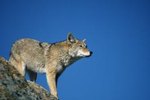
The bobcat (Lynx rufus) is a nocturnal species of feline. These carnivorous mammals, which are the most abundant wildcat on the North American continent, are rather solitary animals that are not frequently seen by others. When it comes to adjusting to new and different environments with ease and swiftness, these family Felidae members are highly versatile.
Geographic Scope of the Bobcat
For the most part, bobcats reside throughout the United States. However, some of these wildcats also live in central and northern portions of Mexico and in southern regions of Canada. The northern United States has more bobcats than other sections of the country, according to the Defenders of Wildlife organization.
Natural Habitat of the Bobcat
When it comes to habitat, bobcats are all over the place. This is partially due to the fact that they go after many different types of prey, from deer and rabbits to mice and raccoons. These territorial cats often live in semi-desert, rugged cliffs, canyons, agricultural sites, chaparral, mountains, coastal swamps, cedar swamps, hardwood forests, and sagebrush steppes. Although bobcats can manage in many types of environments, if they can, they generally gravitate more toward places with ample rugged outcrops, bluffs and cliffs. They also enjoy areas with very thick vegetation. Bobcats also tend to opt for isolated areas. Although not particularly common, bobcats even sometimes reside in suburban locales right alongside human beings.
Bobcat Shelter
Shelter is also a very important element to a bobcat's living environment. Bobcats require shelter both for resting and for fleeing potentially dangerous situations. Individual bobcats often establish numerous dens for themselves, with smaller ones in areas they frequent less often. Some typical shelter types in bobcats include hollow logs, caves, thickets, tree stumps, ledges of stone and heaps of undergrowth.
Bobcat Population
Although bobcats are not classified as endangered animals due to consistent populations, destruction of habitat is indeed a risk for them, according to the IUCN Red List of Threatened Species. Approximately just under one million bobcats exist today, according to the University of Michigan Animal Diversity Web. One possible factor that could contribute to decreasing numbers of these adept hunters is the presence of coyotes. Another factor is hunting, as the felines are often sought after for their distinctly spotted coats. In some regions of the country, agricultural expansion and deforestation may also both be issues for them.
References
- Indiana Department of Natural Resources: Bobcat
- IUCN Red List: Lynx rufus
- Defenders of Wildlife: Bobcat
- National Geographic: Bobcat
- Desert Museum: Bobcat Fact Sheet
- Texas Parks & Wildlife: Bobcat
- Washington Department of Fish & Wildlife: Bobcats
- NJDEP Division of Fish & Wildlife: Bobcat
- Georgia Department of Natural Resources: Bobcat Fact Sheet
- University of Michigan Animal Diversity Web: Lynx rufus
Photo Credits
-
Jupiterimages/liquidlibrary/Getty Images




